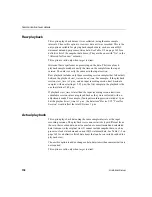
Table of valid key and result data item combinations
146
Historical Server
Examples of valid combinations
•
Login Name, Process ID, Page I/O
•
Process ID, CPU Percent
•
Login Name, Process ID
•
Deadlock Count, CPU Busy Percent
•
Transactions, Rows Deleted, Rows Inserted, Rows Updated
•
Current Engine, Login Name, Process ID
•
Current Engine, Login Name, Process ID, CPU Percent
•
Login Name, Process ID, Page I/O, Connect Time
Timestamp
Valid at server level?
Yes
Required keys:
None
Timestamp Datim
Valid at server level?
Yes
Required keys:
None
Transactions
Valid at server level?
Yes
Required keys:
None
1. These data items infer names from IDs or status types. They are valid in any view
containing the required keys, regardless of the other keys that might also be in the
view. (For example, Database Name is valid in any view containing the key Database
ID; therefore, it would be valid in a view whose keys are Database ID and Process ID.)
2. These data items are available only if you are monitoring Adaptive Server version
11.5 and later.
3. Process ID and Application Name cannot be used in the same view.
4. In versions earlier than 11.5, Cache Name was a key. Currently, Cache Name is a
result. A new key, Cache ID, replaces the key Cache Name. For compatibility, Cache
Name remains valid as a key. However, for efficiency and for forward compatibility,
use Cache ID as the key in new views.
Data item
Required and optional keys
Summary of Contents for 12.5.1
Page 1: ...User s Guide Historical Server 12 5 1...
Page 14: ...xiv Historical Server...
Page 46: ...Configuring multiple instances of Historical Server 32 Historical Server...
Page 56: ...Starting and stopping Historical Server on Windows NT 42 Historical Server...
Page 102: ...hs_terminate_recording 88 Historical Server...






























